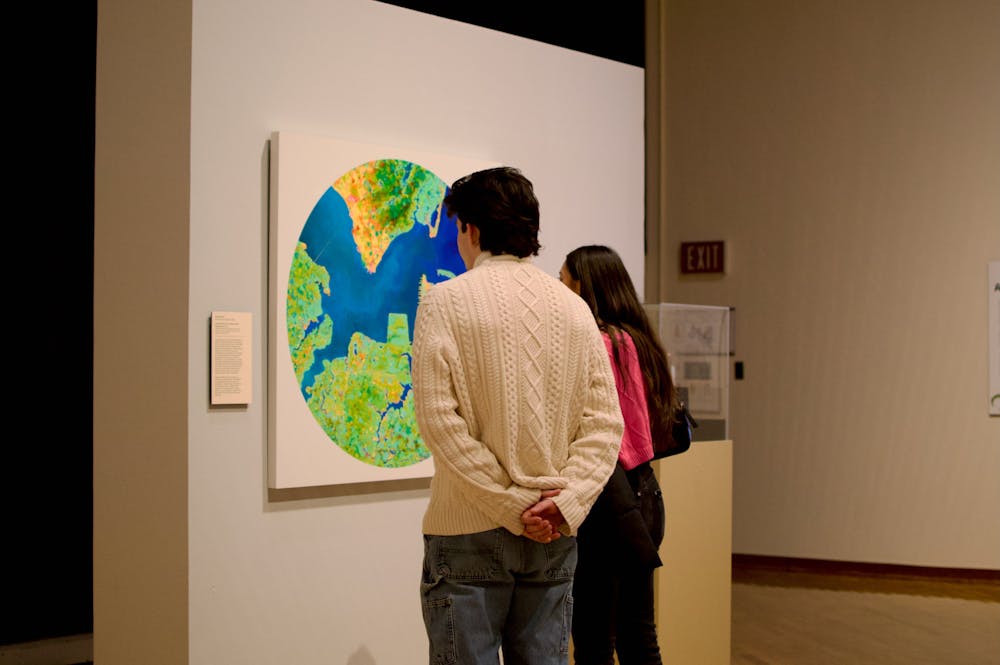At the end of a hallway decorated with frames and canvas, natural light streams in from floor-to-ceiling windows, a fitting illumination for a gallery filled with artwork reflecting the natural world on the other side of the glass.
Sweeping landscapes, apocalyptic scenes and thought-provoking sculptures fill the Farmer Gallery in the Richard and Carole Cocks Art Museum at Miami University. From Jan. 30 to June 8, “The World in Which We Live: The Art of Environmental Awareness” exhibition will provoke museum-goers to examine their place in the world around them.
Jason Shaiman, the museum’s curator of exhibitions, began imagining an exhibition displaying environmental art three years ago after working with visionary landscape artist Mary Edna Fraser, who he considers “the inspiration for the exhibition.” When Shaiman heard that Miami’s 2023-2024 Altman Program in the Humanities and FOCUS Program chose themes of environmental justice, he knew the timing was perfect.
“Art does not stand alone, it’s connected with other areas of research,” Shaiman said. “We want to show how it connects with other disciplines [at Miami].”
To expand its audience and interact with the larger Miami community, the museum has forged partnerships with these and other organizations. The museum will be holding a webinar with Mary Edna Fraser in partnership with the Alumni Association, hosting artist receptions sponsored by the Three Valley Conservation Trust and FOCUS Program, and inviting visual artist LaToya Ruby Fraser in the gallery for her talk in the Altman Program.
“We want to highlight the combination of art and science,” said Jack Green, the director and chief curator of the art museum. “We believe that the exhibition will appeal to people interested in [both disciplines].”
The gallery displays a range of different art forms, from classic oil on canvas paintings to ceramic faucets representing water contamination and a geographic map created from the pigments found in acid mine drainage. The artwork highlights the intersection of art and science while showcasing the harsh realities of environmental degradation.
The process of curating the entire exhibition took many months, with plenty of opportunities for students to get involved. Jessica Pierce, a studio art major with an art history minor, worked as a student intern under Shaiman. Pierce participated in researching artists and their artwork for display, working on labels and signage and the layout of the exhibition within the gallery, all to highlight how science can be transformed into art.
“We were trying to stay pretty neutral and keep it just factual,” Pierce said. “So that's why we have it so science-based, it’s just really to present the facts and then how artists are taking those facts and communicating them.”
While many responses to climate change can be negative, art included, Shaiman and Green wanted to inspire museum-goers. The exhibition is split into two parts: the first shows the problems that arise from environmental harm, while the second part highlights activism through art. At the end of the activism side, there is a Post-It board for people to leave their thoughts.
Along with reaching wider audiences, Green sees the exhibition as a way for the university to make a statement about its commitment to promoting sustainability. The museum makes an effort to be socially conscious, working to display exhibitions that highlight underrepresented communities and touch on issues of social justice.
Enjoy what you're reading?
Signup for our newsletter
“I hope that people go to the museum and [understand] that you can learn about art history, and you can learn about science,” Pierce said.
The exhibition has been open for just over two weeks, and there is still ample opportunity to experience this unique exhibition. With many environmentally-focused events being held at the museum this semester, those involved with the museum hope to continue reaching the wider Miami community.




